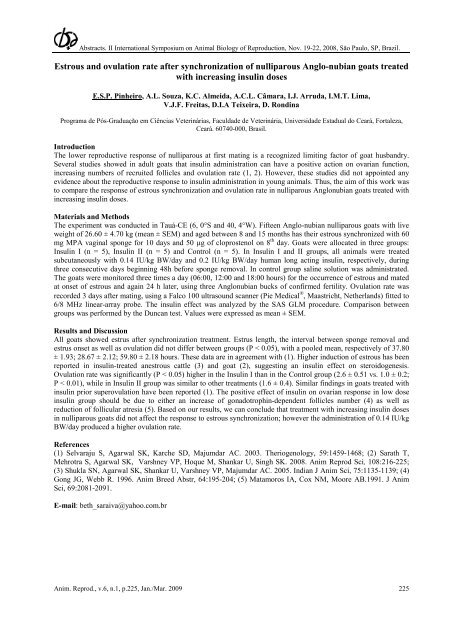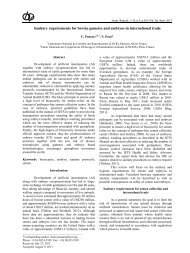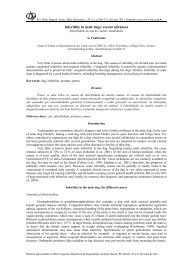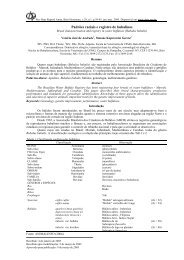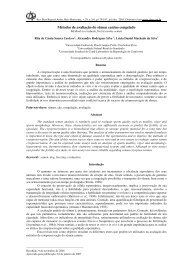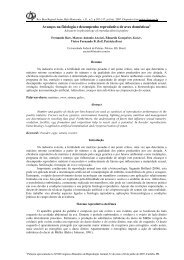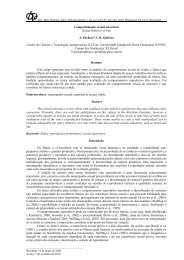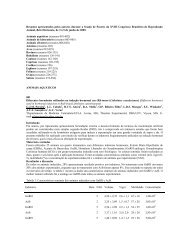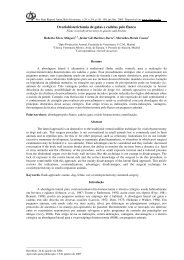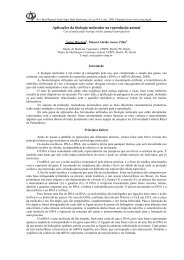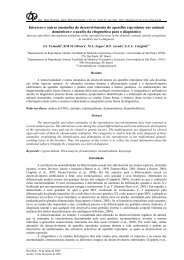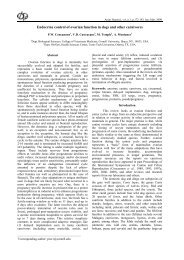Recent advances in ovulation synchronization and superovulation in ...
Recent advances in ovulation synchronization and superovulation in ...
Recent advances in ovulation synchronization and superovulation in ...
Create successful ePaper yourself
Turn your PDF publications into a flip-book with our unique Google optimized e-Paper software.
Abstracts. II International Symposium on Animal Biology of Reproduction, Nov. 19-22, 2008, São Paulo, SP, Brazil.<br />
Estrous <strong>and</strong> <strong>ovulation</strong> rate after <strong>synchronization</strong> of nulliparous Anglo-nubian goats treated<br />
with <strong>in</strong>creas<strong>in</strong>g <strong>in</strong>sul<strong>in</strong> doses<br />
E.S.P. P<strong>in</strong>heiro, A.L. Souza, K.C. Almeida, A.C.L. Câmara, I.J. Arruda, I.M.T. Lima,<br />
V.J.F. Freitas, D.I.A Teixeira, D. Rond<strong>in</strong>a<br />
Programa de Pós-Graduação em Ciências Veter<strong>in</strong>árias, Faculdade de Veter<strong>in</strong>ária, Universidade Estadual do Ceará, Fortaleza,<br />
Ceará. 60740-000, Brasil.<br />
Introduction<br />
The lower reproductive response of nulliparous at first mat<strong>in</strong>g is a recognized limit<strong>in</strong>g factor of goat husb<strong>and</strong>ry.<br />
Several studies showed <strong>in</strong> adult goats that <strong>in</strong>sul<strong>in</strong> adm<strong>in</strong>istration can have a positive action on ovarian function,<br />
<strong>in</strong>creas<strong>in</strong>g numbers of recruited follicles <strong>and</strong> <strong>ovulation</strong> rate (1, 2). However, these studies did not appo<strong>in</strong>ted any<br />
evidence about the reproductive response to <strong>in</strong>sul<strong>in</strong> adm<strong>in</strong>istration <strong>in</strong> young animals. Thus, the aim of this work was<br />
to compare the response of estrous <strong>synchronization</strong> <strong>and</strong> <strong>ovulation</strong> rate <strong>in</strong> nulliparous Anglonubian goats treated with<br />
<strong>in</strong>creas<strong>in</strong>g <strong>in</strong>sul<strong>in</strong> doses.<br />
Materials <strong>and</strong> Methods<br />
The experiment was conducted <strong>in</strong> Tauá-CE (6, 0°S <strong>and</strong> 40, 4°W). Fifteen Anglo-nubian nulliparous goats with live<br />
weight of 26.60 ± 4.70 kg (mean ± SEM) <strong>and</strong> aged between 8 <strong>and</strong> 15 months has their estrous synchronized with 60<br />
mg MPA vag<strong>in</strong>al sponge for 10 days <strong>and</strong> 50 µg of cloprostenol on 8 th day. Goats were allocated <strong>in</strong> three groups:<br />
Insul<strong>in</strong> I (n = 5), Insul<strong>in</strong> II (n = 5) <strong>and</strong> Control (n = 5). In Insul<strong>in</strong> I <strong>and</strong> II groups, all animals were treated<br />
subcutaneously with 0.14 IU/kg BW/day <strong>and</strong> 0.2 IU/kg BW/day human long act<strong>in</strong>g <strong>in</strong>sul<strong>in</strong>, respectively, dur<strong>in</strong>g<br />
three consecutive days beg<strong>in</strong>n<strong>in</strong>g 48h before sponge removal. In control group sal<strong>in</strong>e solution was adm<strong>in</strong>istrated.<br />
The goats were monitored three times a day (06:00, 12:00 <strong>and</strong> 18:00 hours) for the occurrence of estrous <strong>and</strong> mated<br />
at onset of estrous <strong>and</strong> aga<strong>in</strong> 24 h later, us<strong>in</strong>g three Anglonubian bucks of confirmed fertility. Ovulation rate was<br />
recorded 3 days after mat<strong>in</strong>g, us<strong>in</strong>g a Falco 100 ultrasound scanner (Pie Medical ® , Maastricht, Netherl<strong>and</strong>s) fitted to<br />
6/8 MHz l<strong>in</strong>ear-array probe. The <strong>in</strong>sul<strong>in</strong> effect was analyzed by the SAS GLM procedure. Comparison between<br />
groups was performed by the Duncan test. Values were expressed as mean ± SEM.<br />
Results <strong>and</strong> Discussion<br />
All goats showed estrus after <strong>synchronization</strong> treatment. Estrus length, the <strong>in</strong>terval between sponge removal <strong>and</strong><br />
estrus onset as well as <strong>ovulation</strong> did not differ between groups (P < 0.05), with a pooled mean, respectively of 37.80<br />
± 1.93; 28.67 ± 2.12; 59.80 ± 2.18 hours. These data are <strong>in</strong> agreement with (1). Higher <strong>in</strong>duction of estrous has been<br />
reported <strong>in</strong> <strong>in</strong>sul<strong>in</strong>-treated anestrous cattle (3) <strong>and</strong> goat (2), suggest<strong>in</strong>g an <strong>in</strong>sul<strong>in</strong> effect on steroidogenesis.<br />
Ovulation rate was significantly (P < 0.05) higher <strong>in</strong> the Insul<strong>in</strong> I than <strong>in</strong> the Control group (2.6 ± 0.51 vs. 1.0 ± 0.2;<br />
P < 0.01), while <strong>in</strong> Insul<strong>in</strong> II group was similar to other treatments (1.6 ± 0.4). Similar f<strong>in</strong>d<strong>in</strong>gs <strong>in</strong> goats treated with<br />
<strong>in</strong>sul<strong>in</strong> prior super<strong>ovulation</strong> have been reported (1). The positive effect of <strong>in</strong>sul<strong>in</strong> on ovarian response <strong>in</strong> low dose<br />
<strong>in</strong>sul<strong>in</strong> group should be due to either an <strong>in</strong>crease of gonadotroph<strong>in</strong>-dependent follicles number (4) as well as<br />
reduction of follicular atresia (5). Based on our results, we can conclude that treatment with <strong>in</strong>creas<strong>in</strong>g <strong>in</strong>sul<strong>in</strong> doses<br />
<strong>in</strong> nulliparous goats did not affect the response to estrous <strong>synchronization</strong>; however the adm<strong>in</strong>istration of 0.14 IU/kg<br />
BW/day produced a higher <strong>ovulation</strong> rate.<br />
References<br />
(1) Selvaraju S, Agarwal SK, Karche SD, Majumdar AC. 2003. Theriogenology, 59:1459-1468; (2) Sarath T,<br />
Mehrotra S, Agarwal SK, Varshney VP, Hoque M, Shankar U, S<strong>in</strong>gh SK. 2008. Anim Reprod Sci, 108:216-225;<br />
(3) Shukla SN, Agarwal SK, Shankar U, Varshney VP, Majumdar AC. 2005. Indian J Anim Sci, 75:1135-1139; (4)<br />
Gong JG, Webb R. 1996. Anim Breed Abstr, 64:195-204; (5) Matamoros IA, Cox NM, Moore AB.1991. J Anim<br />
Sci, 69:2081-2091.<br />
E-mail: beth_saraiva@yahoo.com.br<br />
Anim. Reprod., v.6, n.1, p.225, Jan./Mar. 2009 225


